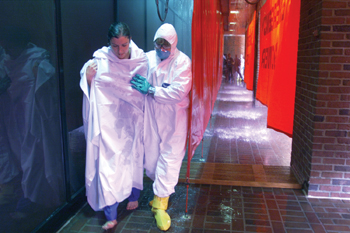
Kelley Work with Environmental Health and Safety helps a patient through the decontamination showers during a bioterrorism drill at Vanderbilt. (photo by Dana Johnson)
Vanderbilt would be ready for disaster
Vanderbilt Medical Center faculty and staff have quickly responded to new challenges in treating patients affected by potential terrorist acts, as the nation remains on high alert with universities and hospitals considered “soft” targets.
In an e-mail communication to faculty and staff, Chancellor Gordon Gee emphasized “much has been done, and much continues to be done, to ensure the safety and security of our Vanderbilt community.”
The medical center has had longstanding emergency preparedness plans, and can be implemented at a moment’s notice. Those plans have been updated and modified to reflect the changing environment.
Some of the preparedness measures taken over the last year include:
• Numerous training classes have been held so health care providers in the Vanderbilt community can quickly spot potential bioterrorism activities.
Those classes have focused on what health care providers can expect when presented with anthrax, plague, smallpox, viral hemorrhagic fevers and botulism, and outlined treatment procedures for each of these diseases.
• Vanderbilt Emergency Department faculty and staff have been donning respirators and hazardous materials response suits as part of an eight-hour training class designed to protect and prepare them to handle patients who could present from a biological, radiation or chemical accident or act of terrorism.
• Members of the Vanderbilt Children’s Hospital and Vanderbilt Medical Center disaster committee took their expertise in disaster preparedness to the annual National Association of Children’s Hospitals and Related Institutions (NACHRI) conference to train other hospitals how to better prepare for disasters.
• Vanderbilt Medical Center hosted a class on Emergency Medical Service Operations and Planning for Weapons of Mass Destruction, offered by Texas A & M University’s National Emergency Response and Rescue Training Center (NERRTC), and is part of the National Domestic Preparedness Consortium’s curricula to improve the abilities of jurisdictions to combat domestic terrorism. Emergency Medical Services Operations and Planning for Weapons of Mass Destruction, an operations or technician-level course, is one of several taught by the NERRTC and funded by the Department of Justice.
• VUMC’s disaster committee has tested a new sub plan of the hospital’s disaster plan, that of responding to disasters involving biological agents. In the largest drill ever held by the Medical Center, more than 150 participants went through the motions of treating a community-wide exposure to anthrax. The Emergency Operations Center was activated and, from there, command staff directed the functions of faculty and staff as patients began arriving for treatment.
Dr. Ian Jones, assistant professor of Emergency Medicine and operations director for the Vanderbilt Emergency Department, said the threat of bioterrorism had been around since the sixth century, BC, when Assyrians poisoned the wells of their enemies with rye ergot. Since the Sept. 11 attacks, and the ensuing cases of anthrax exposures, America has been on heightened alert for even more threats of bioterrorism.
“The threat is real,” Jones said. “The Russians had a sophisticated bioweapons facilities in Koltsovo, Novosibirsk. Throughout the 1990s this was a 4,000-person, 30-building facility that concentrated on building bioweapons.”
Our preparedness over the years will serve us well in these uncertain times,” Gee said. “In any case, please know that the safety — emotional as well as physical — of each and every member of this community is our highest priority.”













